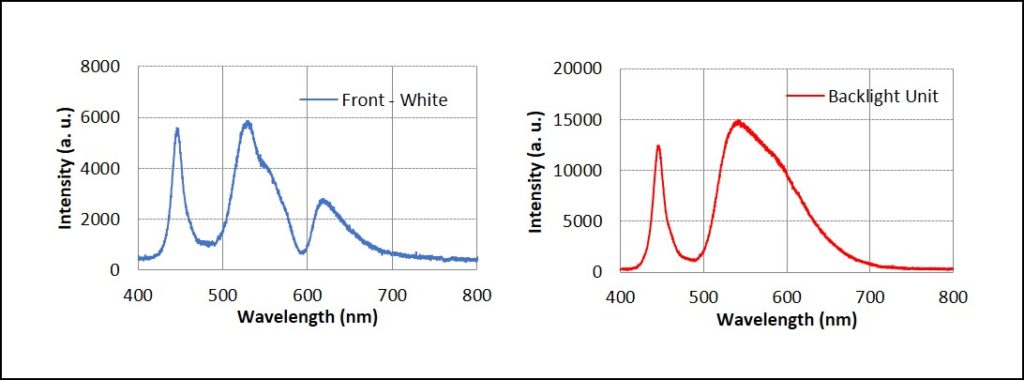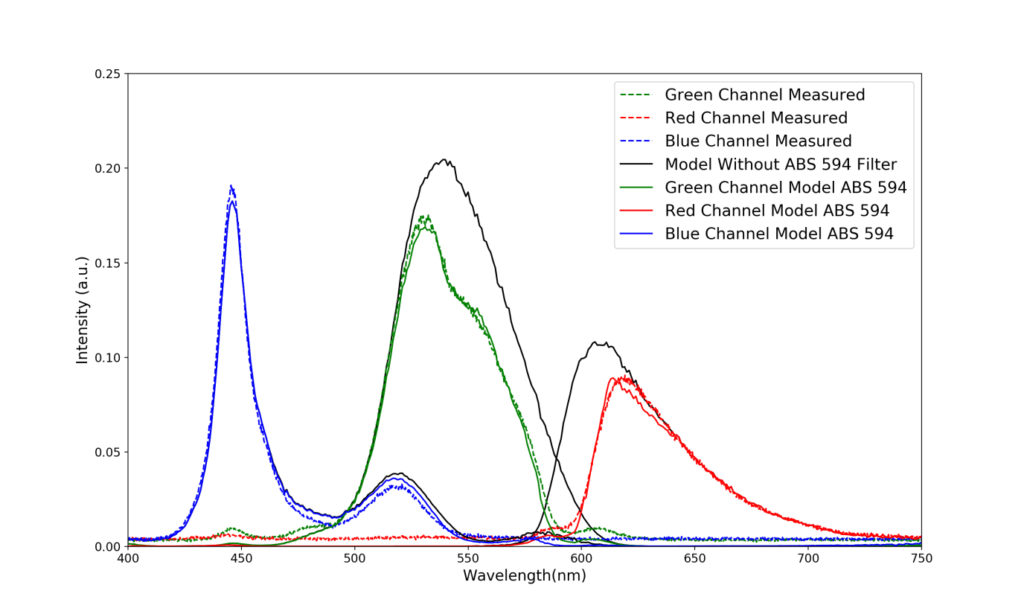A collaboration by Peter Palomaki & Matthew Bertram
LG, known mostly for their OLED display technology, has recently been promoting their new LCD technology called “Nano Cell.” While the exact inner workings are a closely held secret, this technology is of interest to the display industry because it is being promoted as a novel way to increase color gamut and improve viewing angle. But what exactly is it and what does it do!? We have some speculation as to what LG is doing to differentiate their LCD line of displays to compete with Samsung and others who are adopting quantum dots to achieve wide color gamut (WCG).
Color gamut has become an important specification in the display industry in recent years. Display companies have explored many different technologies in order to improve color gamut including narrow red and green phosphors, quantum dots, color filter improvements, even the liquid crystal itself. We took a deep dive into patents and literature, as well as characterization of an actual Nano Cell display in an attempt to better understand exactly what technology is being used, how much it improves color, and what about it is “nano.”
So What Exactly is this Nano Cell Technology?
Our investigation of Nano Cell technology led us down a bit of a rabbit hole. It was discovered that LG previously called it “IPS-Nano”. This technology appears to be an incorporation of LG’s IPS (in-plane switching) liquid crystal technology along with an undisclosed nanomaterial technology, apparently around 1nm in size. There are two major benefits that LG touts in their Nano Cell technology: 1- Viewing angle enabled by IPS technology and 2 – WCG enabled by the mysterious new absorbing nanoparticle technology. The increase to color gamut is described in Figure 1. When combined, the color quality at up to 60 degrees from normal is claimed to be as good as head on. Recently LG re-branded the technology, giving more weight to the “nano” part (presumably because the marketing was predicted to make a bigger impact competitive with Samsungs QLED line). We tend to agree that “Nano Cell technology” rolls off the tongue a bit easier than “IPS-Nano technology.” Let’s dive into these two advancements.


Measurements on a Nano Cell TV

Patents Support the Suspicion
LG Chemical recently submitted a patent application that describes the use of narrow-band absorbing dye complexes dispersed in a polymer film (KR20170101574A). In this approach, the dye would act as a selective absorber (with no emission) in a stand-alone film or coat on an existing film/glass layer within the display. One reason this approach may not have been used before is that many molecular absorbers cannot withstand the high light flux environment of LCD displays, they tend to photo-bleach. The patent calls out a number of potential molecular absorbers that could be used in this approach. We identified two that have optical spectra that fit well with our measurements of a Nano Cell display (Figure 3). The Abs594 dye has a unique shoulder peak around 550 nm. This feature could very well be the reason the measured Nano Cell display spectra show a depression on the high energy side of the green peak (Figure 4). This dye reduces cross-talk between the green and red channels. The FDB007 dye is an example of a dye that could be used to prevent cross-talk between the blue and green channels. It absorbs strongly at 500 nm. Based on our modeling (below) we believe that the Nano Cell technology contains only one dye, similar to Abs594.
Modeling of absorbers
In an effort to further confirm that LG is using a molecular absorber, and to compare LGs Nano Cell technology to competing technologies, we modeled the output of various down-converters with and without an additional filtering layer (presumably the one used in the Nano Cell display) beyond the traditional CFA.
Knowing that the Nano Cell display uses a YAG backlight, we first modeled what we predict is within a Nano Cell display – YAG backlight + CFA + Abs594. The result (Figure 7 colored solid traces) is an optical spectrum this is nearly identical to the measured Nano Cell spectrum (Figure 7 colored dashed traces), further confirming our suspicion that this technology is in fact a molecular absorber similar to Abs594. When compared to a YAG backlight + CFA only (no absorber, Figure 7, black trace), it is clear that the shoulder depression in the green is a unique feature of the Abs594 absorber layer.

So how does the Nano Cell gamut compare to other competing technologies? Could the molecular absorber layer be useful in other situations?
Comparing technologies: Nano Cell, Phosphors, QDs
Display companies love to tell you how awesome their technology is compared to the competition, so we set out to compare various technologies in use today to achieve WCG displays. All of the following data is modeled data (not measured), so keep in mind that actual devices could vary, but we think this is a good approximation of how these technologies stack up.
The modeled components of a Nano Cell display (YAG + color filter + absorber) considerably improve the resulting gamut when compared to a display with no absorber layer. It is clear the molecular absorber is useful for the YAG backlight. From our calculations, the gamut can be boosted by 10% simply by including this absorbing layer, from 82% to 92% of DCI-P3 color space (Figure 8)
When using either narrow phosphors (red=KSF, green=beta-SiAlON) or QDs (red=InP 44nm FWHM, green=InP 40 nm FWHM), there is very little improvement in DCI-P3 gamut coverage with the addition of an absorber layer. However, these technologies show much higher gamut than the YAG + color filter or the Nano Cell technology, both coming in at nearly full coverage (97-98%, Figure 8)

While it is clear that QDs and narrow phosphors can achieve a wider gamut than LGs Nano Cell technology, it would be interesting to measure off-angles to compare the claims that the Nano Cell technology (IPS) improves the color at off-axis viewing angles. This is where LGs technology could show a benefit over competitors.
It’s worth noting that while the increase in gamut for QDs and narrow phosphors is minimal when using the DCI-P3 color space, the improvement is significant when comparing to Rec2020 color space (a 7% improvement for both narrow phosphors and QDs, Figure 10).
Riding QD coattails for the nano-win
We think the selective absorber approach is a cost-effective way to ride the marketing coattails of Samsung who has invested heavily in QLED quantum dot technology (which is a nanoparticle technology). Ultimately though, tricks like selective absorbers are not as effective as truly narrow-band emitters. A comparison of the gamut with QDs compared to the measured Nano Cell is a clear no-contest.
From a marketing standpoint it makes perfect sense that LG is hopping on the nano-tech bandwagon, trying not to be left behind by QD technology. While LG may be able to claim improvements in viewing angle over their QD-competition (likely true – we didn’t test it), their claims that this technology is enabled by 1 nm nanoparticles is misleading. In reality, the absorbing species is most likely a molecular dye (perhaps about 1nm in size) but not a nanoparticle at all. In addition, the wide viewing angle is enabled by IPS liquid crystal technology, not by the absorbing layer.
Final thoughts
Mounting evidence supports our claim that LG is probably using a combination of two technologies to create what they call Nano Cell technology. The first is their existing IPS display technology which improves viewing angle. The second is a simple dye absorber inside the LCD panel which improves color. Anyone familiar with nanoparticles may cry foul of the marketing speak of 1nm uniform materials, however. We did consider that the technology could be a plasmonic absorber (metal nanoparticle) but the convincing overlay of Abs594 dye was a far better fit than any plasmonic absorber we could find. Another thing to note is that most plasmonic nanoparticles are typically 5-30nm in diameter.
The approach of using a cost-effective absorbing species (in this case a molecular dye) as an additional layer to improve gamut and compete with QD-enabled displays is really a smart move by LG. It improves gamut, and when coupled with their IPS liquid crystal technology has some benefits over QD displays. Gamut at off-center angles may be improved compared to other high-color technologies, but the native gamut is not nearly as large as QD or KSF enabled displays. As display companies attempt to push the boundaries of gamut closer to Rec2020, this may be an effective way to squeeze out every little bit of color possible, but for the time being, QDs and narrow phosphors will continue to rule the day when it comes to wide color gamut technology.
With the advent of QD color filters and QDs on-chip, the molecular absorber technology may only be around for a short time. We’ll see if it helps LG differentiate enough to compete with Samsung in the non-OLED wide color gamut display space.
Thanks for reading – we would love to hear your thoughts.
About the Authors:
Peter is the owner and chief scientist at Palomaki Consulting, a firm specializing in helping companies solve big problems at the nanoscale. If you have questions about quantum dots or other nanomaterial technologies, don’t hesitate to reach out! Subscribe to our email list so you don’t miss out on updates like this one! peter@palomakiconsulting.com
Matt has worked extensively in the quantum dot industry across several companies and is currently the owner of Bertram Engineering LLC a product development consultancy specializing in nanomaterials for display. matt@bertramengineering.com